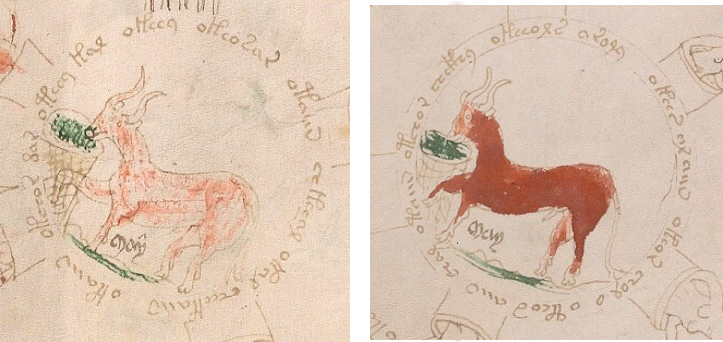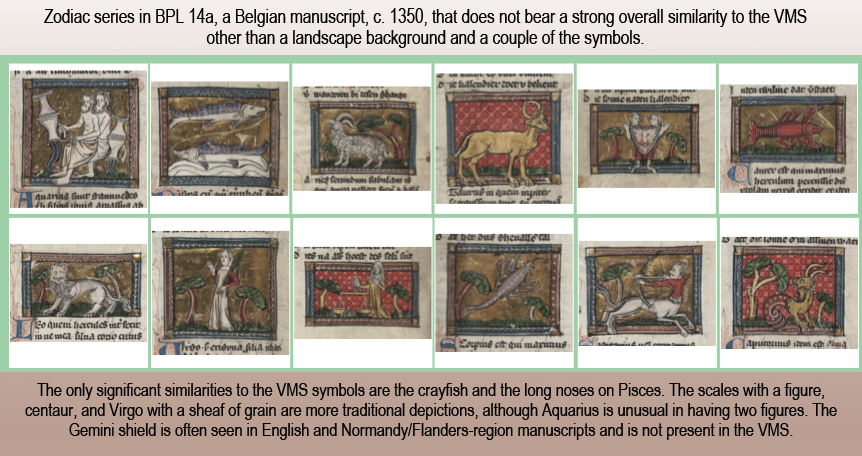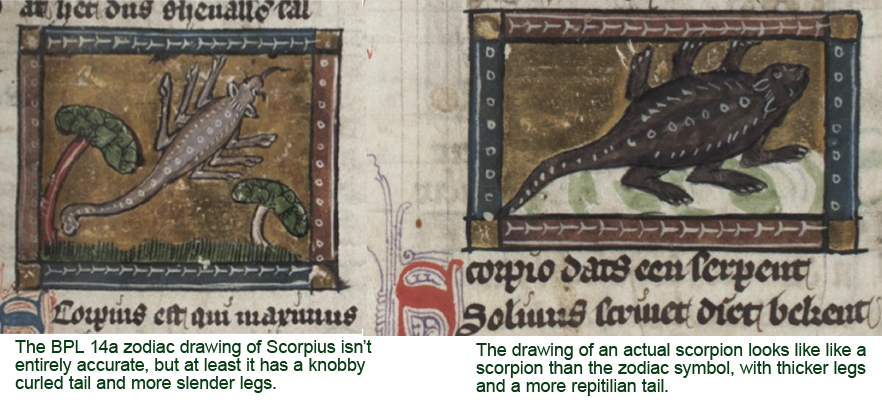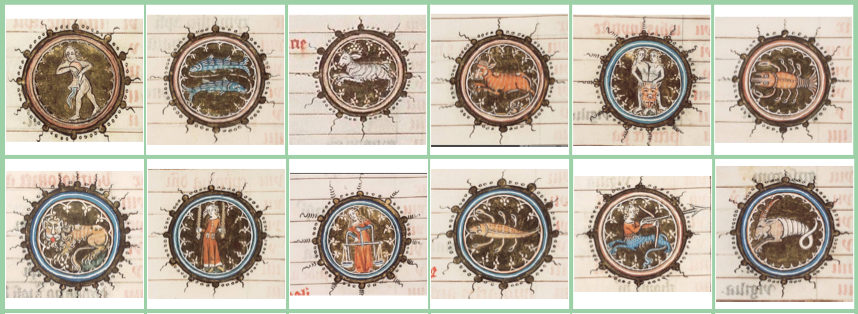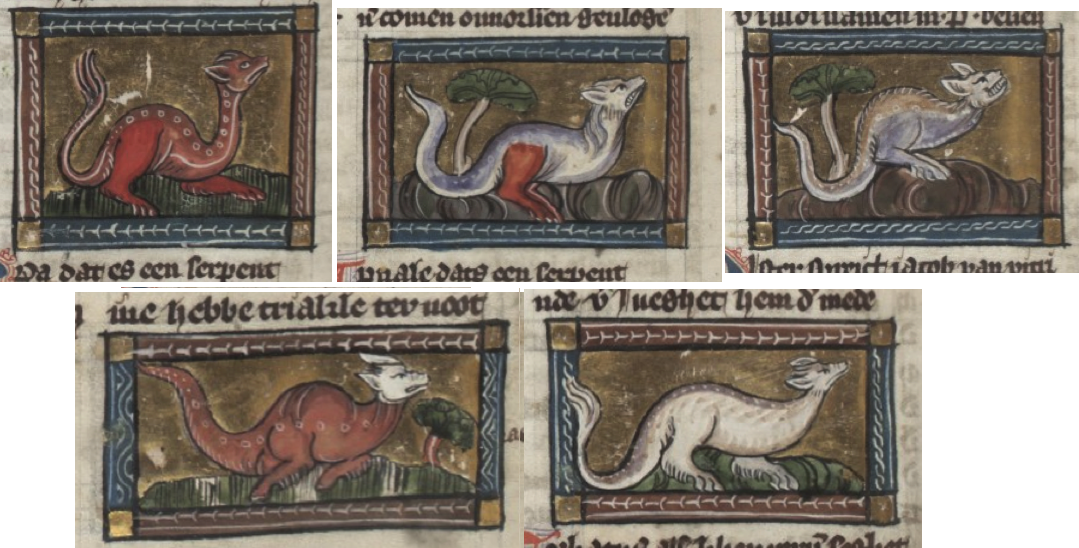I posted a blog on long-necked Taurus in April 2016, but was reluctant to add a specific picture of a red bull with a strikingly long neck. My focus was zodiac symbols and I didn’t want to include dozens of bulls that were not in zodiacs. I’ve decided to post this one, because the manuscript does have a zodiac series and the bull (which is in a different section) is so strikingly similar to the VMS.
There are two drawings of bulls in the VMS, one painted a little darker than the other. The placement of eyes and style of the nose differ, but their bodies are essentially the same shape:
In another manuscript that predates the VMS by about half a century, we find this drawing of a bull. It’s not a zodiac symbol, it’s in the bestiary section, but it is labeled “Taurus”:
I lightened the background (right) to make it easier to see the shape and pose. Note the long neck, long white curved horns, raised front leg, reddish coloration, very long tail, narrow pointed penis, and landscape background. Even though the background is rectangular and more ornate, the bull is very similar to the lighter VMS Taurus, including the angle of the head.
This drawing is more similar to the VMS bull than the one in the zodiac section. The zodiac Taurus is amber and faces the other way (and doesn’t have the front leg raised). The rest of the zodiac is based on traditional symbols and differs from the VMS in a number of ways—Sagittarius is a centaur, Leo has a man-face, the scorpion is more-or-less naturalistic, and the Libra scales are held by a female figure. It fits in with the H 437 tradition in the previous blog. The only significant commonalities with the VMS are the crayfish and the long noses on Pisces.
Are the similarities between the VMS zodiac bull and the bestiary bull coincidental? Why would these two long-necked bulls look so much alike when the zodiac drawings have little in common?
Maybe it’s not entirely a coincidence. If we look at Scorpius in BPL 14a, it is roughly like a scorpion, and yet the scorpion in the bestiary section (right), with fatter legs and body and snake-like tail, leans more toward medieval drawings of lizards and tarasques than a scorpion. Even though it’s drawn at a different angle, in some ways the bestiary critter is more similar to lizard-style Scorpiuses than the slightly more realistic one in the zodiac:
It seems possible that the illustrators of BPL 14a were consulting different sources when drawing the zodiac versus the bestiary. What’s even more puzzling is that the description next to the lizardly scorpion in the bestiary describes the stinger and knobby tail of a real scorpion, and yet these features are not in the drawing.
Crayfish, Centaur, and Libra-with-Figure
BPL 14a expresses themes that were common to the region, and which continued well into the 15th century, as illustrated by these two examples, one from the southern Netherlands (c. 1360) and a later, similar one in a 1455 Book of Hours (both now in The Hague).
Note how these differ from BPL 14a in colors and the shape that encloses the symbols, but they are the same basic themes: Virgo with grain, Libra with figure, somewhat naturalistic scorpion, shield Gemini, centaur-Sagittarius, and crayfish:
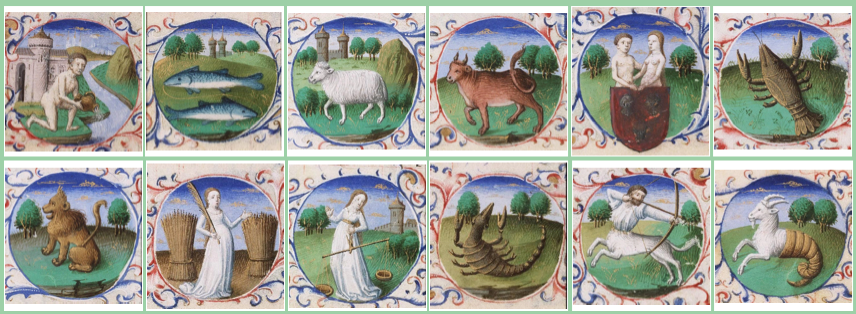
Like BPL 14a, the KB zodiac has Gemini shield, crayfish, Virgo with grain, Libra with a figure, a real scorpion, and centaur Sagittarius. Except for Aquarius and Leo, it’s clearly the same basic template.
Some of the Parisian and Castilian zodiacs follow this template, as well, except that Gemini does not have a shield, as in Egerton 1070, and BL Add 18851 and Add 38126.
Is there a match for Pisces in the bestiary?
Is there a pattern? Can we find evidence that VMS zodiac animals were taken from bestiaries?
It turns out that the fish section in BPL 14a is fairly extensive, and several drawings have long noses and double dorsal fins. Here are some examples, four of which have notably long snouts: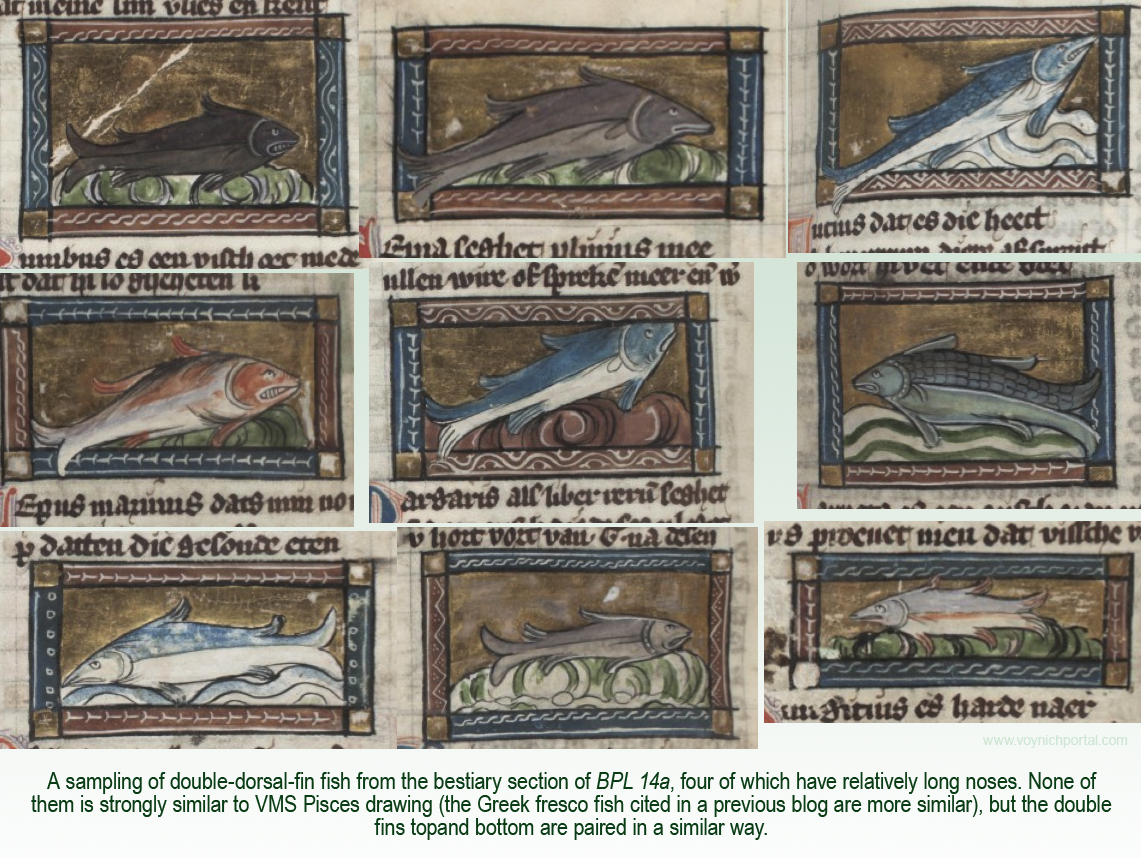
But… I don’t think they match the VMS as well as the Greek fresco fish mentioned in a previous blog.
What about Leo?
VMS Leo is distinctive for having a long neck (as do several of the other critters), only a hint of a mane, and possibly a furry coat. It has been suggested this might be a panther/leopard rather than a lion, but young lions are shaggy, with spots, and do not yet have manes, so even a cat with skimpy mane could represent a young or female lion.
This drawing in the feline section of the BPL 14a bestiary caught my eye, with the tilted head and its tail through its leg, but it is explicitly labeled “pardus” (abbreviated p[er]dus), so it is intended to be in the leopard rather than the lion family. It’s not posed quite like the VMS, either, but I thought I would include it for reference:
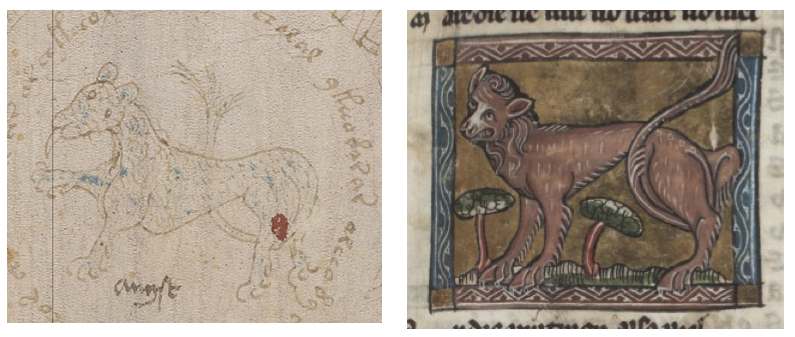 Note the faint suggestion of blue on the VMS lion.
Note the faint suggestion of blue on the VMS lion.
There are a few zodiac and bestiary lions that are blue. Most of them originate in England or northern France/Normandy. The one in Walters W.37 has its tail through its leg, but has a distinctive mane. Trinity B-10-9 has a man-face and Morgan M.729 is posed quite differently (although it should be noted that Scorpius is rather tarasque-like and Gemini is an affectionate couple). Add MS 21926 (below) has a blue lion with one leg raised and only the hint of a mane:
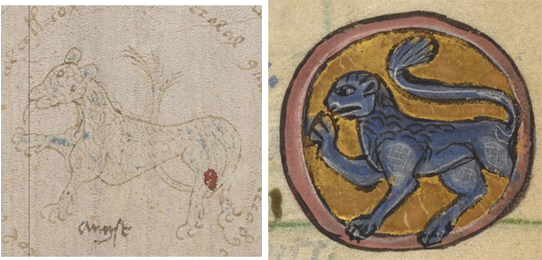 The blue lion in Cotton MS Galba A XVIII (below) might be one of the earliest zodiacs with a blue lion (c. 9th century). It is facing the other way, but interestingly, several of the animals are standing on bumpy terrains, as are some of the VMS critters, and Sagittarius is a human.
The blue lion in Cotton MS Galba A XVIII (below) might be one of the earliest zodiacs with a blue lion (c. 9th century). It is facing the other way, but interestingly, several of the animals are standing on bumpy terrains, as are some of the VMS critters, and Sagittarius is a human.
It has been noticed by several researchers that the crayfish in this zodiac appears to have two heads. However, the zodiac also differs from the VMS in that the twins are male warriors, and Libra is held by a figure. Scorpius appears to be a two-headed serpent, a fairly unique depiction:
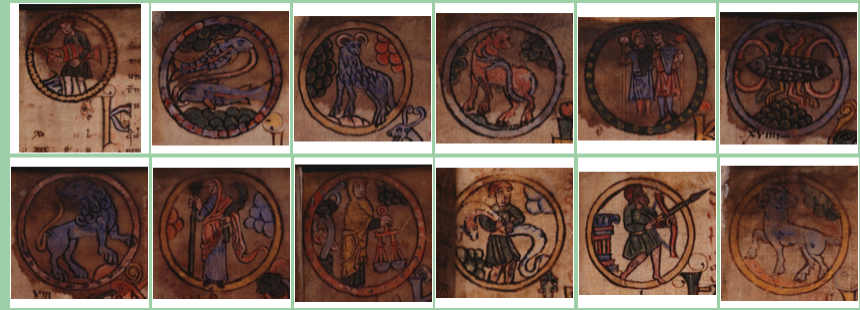 But getting back to the blue lion, what does it have to do with bestiaries?
But getting back to the blue lion, what does it have to do with bestiaries?
I think it was Ellie Velinska who first brought this to my attention, but there’s a bluish-gray bestiary feline with a suggestion of fur or spots, a sparse mane, a raised paw, and its tail through its leg that is more similar to the VMS Leo than anything I’ve seen in a zodiac. Note also the very rounded shoulder joint on both the VMS and the bestiary lion:
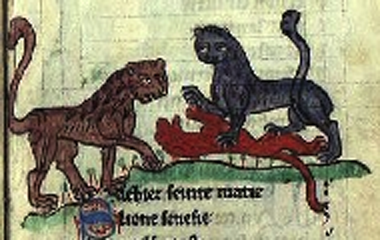 Glancing through the bestiary, I noticed one other thing related to VMS critters in general…
Glancing through the bestiary, I noticed one other thing related to VMS critters in general…
In the serpent/dragon section of BPL 14a are a number of dragon-like critters that reminded me of the critter nosing a big plant in the VMS, in the sense of being vague and hard to figure out. These all are named, some of them with the names of real snakes (like “boa”), but they do not resemble snakes in any way. Sometimes it’s impossible to identify medieval creatures without the captions:
So what does all this mean?
I’m not sure yet, there’s still much work to be done… the VMS is consistent with a certain branch of zodiac illustrative traditions, as I hope I’ve demonstrated in previous blogs, and yet it’s possible the details, the animals and figures, were drawn from other sources. The VMS illustrator may have studied the zodiac motifs and then plugged in content from somewhere else.
I know that’s easy to say, but not so easy to prove, even if the resemblance of VMS Taurus to the bestiary bull is quite striking. It’s probably a good idea to keep in mind that VMS exemplars might be less obvious than assumed.
J.K. Petersen
© Copyright 2018 All Rights Reserved

